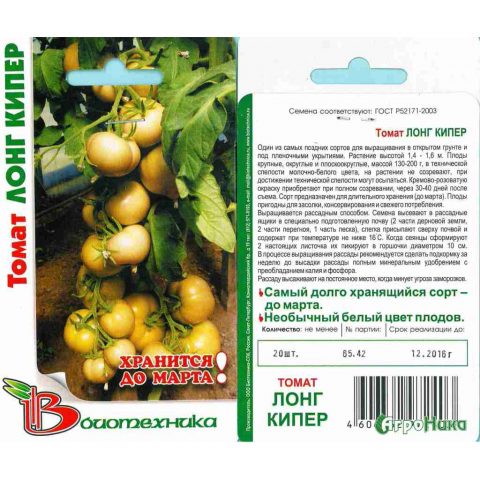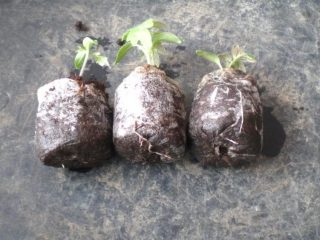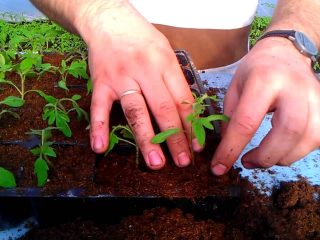Content
The Long Keeper tomato is a late-ripening variety. The breeding of the tomato variety was carried out by breeders of the seed-growing company "Gisok-Agro". The authors of the variety are: E. A. Sysina, K. B. Bogdanov, M. I. Ushakov, S. L. Nazina, E. N. Andreeva. The Long Keeper tomato variety was included in the State Register in 1999. The crop is suitable for cultivation in open ground, in heated and unheated greenhouses. Thanks to its high technical characteristics, it can be grown throughout Russia.
Characteristics and description of the tomato variety Long Keeper
When considering the characteristics of a culture, the following must be considered:
- name of the tomato variety – Long Keeper;
- late-ripening determinate variety;
- high level of productivity;
- long shelf life;
- the ripening period is 128-133 days after transplantation into the greenhouse;
- unripe fruits have a light milky hue, after ripening the color changes to pearl pink;
- a ripe fruit weighs about 125-250 g, in some cases the weight can reach 330-350 g;
- since the fruits are universal, they can be eaten fresh or used for canning;
- Each bush yields up to 4 kg of crop;
- seeds must be sown 70 days before the intended planting in the greenhouse;
- per 1 sq. m it is allowed to plant a maximum of 8 tomato bushes;
- high level of resistance to many types of diseases.
The Long Keeper tomato variety can grow up to 1.5 m in height. The leaves are medium in size, rich green in color with a metallic tint. High yields can be obtained if seedlings are formed into 1 stem. Due to the large height, it is necessary to take care of support, and do not forget about regular stepsoning. It is recommended to grow the crop in a greenhouse; in the south of Russia it is allowed to plant it in open ground.
Description of fruits
Ripe tomatoes of the Long Keeper variety can be round or flat-round in shape. The weight of a ripe fruit varies from 130 to 200 g, in some cases it can reach 350 g. The peel of the tomato is quite smooth, unripe fruits are white, and gradually, as they ripen, the color becomes light pink.
As practice shows, the process of fruit ripening is impossible on bushes, as a result of which green tomatoes must be picked green and sent for ripening. If tomatoes remain on the bushes, then upon reaching technical maturity they begin to crumble. The number of seed nests is 4 pcs. If all recommendations are followed and high-quality care of the plantings is taken, it is possible to collect from 1 sq. m from 7 kg of fruit.
Since the Long Keeper tomato variety is universal, it can be eaten fresh or used for canning.Judging by the characteristics, the taste of ripe fruits remains at an average level, as a result of which they are used mainly for canning.
Fruiting time and yield
If we take into account the description of Long Keeper tomatoes, it is worth noting that this species is late, as a result of which the harvest begins 130 days after transplanting the seedlings to a permanent place of growth. From each bush you can collect up to 4 kg of fruit, and from each square. m from 8 kg.
Sustainability
Tomato varieties Long Keeper have a high level of resistance to the following types of diseases:
- cladosporiosis;
- tobacco mosaic;
- Fusarium
If ventilation is impaired, tomatoes may suffer from late blight. To treat tomatoes, they use special chemicals or resort to folk remedies.
Advantages and disadvantages
Before growing seedlings, many experienced gardeners advise first studying photos and reviews of the Long Keeper tomato; in addition, do not forget about the description of the variety, advantages and disadvantages.
Among the advantages of the Long Keeper tomato variety, the following main points can be highlighted:
- high level of resistance to many types of diseases and pests that are characteristic of this type of crop;
- if necessary, it can be transported over long distances without losing its presentation, which is a big plus if tomatoes are grown on an industrial scale for further sale;
- high level of productivity - from each bush it is possible to collect up to 4 kg of ripe fruits;
- stable yield, regardless of weather conditions;
- maintaining an attractive appearance even after a long period of storage.
Despite such a number of significant advantages, Long Keeper tomatoes also have some disadvantages, including:
- it is necessary to tie up the bushes during the growth process, since they can break under the weight of the fruit;
- taste qualities are rated at an average level;
- To grow a crop, a greenhouse is required; planting material in open ground is allowed in the south of Russia;
- Since tomatoes do not ripen on the bushes, they must be picked and sent for ripening at home.
Only after the information has been studied in detail can a decision be made about planting a specific crop.
Rules for planting and care
Before planting, planting material must be disinfected. To do this, use a weak solution of potassium permanganate. After this, the seeds are hardened for some time and only then planted to produce seedlings.
If necessary, you can place the roots of tomatoes before planting for a while in a rooting solution, which will allow the tomatoes to take root much faster.
Growing seedlings
To grow seedlings, it is necessary to use high-quality soil. A mixture of turf, humus and sand is excellent for these purposes; the proportion should be kept as follows - 2:2:1. To plant seeds, you can use any container - disposable cups, peat cups, flower pots.
It is recommended to sow seeds in the second half of March - 2 months before the intended planting of seedlings in a greenhouse or open ground. A distance of up to 3 cm must be maintained between the seeds. Peat is poured on top of the planting material in a layer of up to 1 cm.
Transplanting seedlings
Tomato variety Long Keeper is recommended to be planted in a greenhouse in a permanent place of growth in the second half of May. Planting material is planted after the seedlings are 60-65 days old. 7 days before the planned planting, it is necessary to pre-prepare the beds. To do this, it is recommended to add potassium-phosphorus fertilizers to the soil.
In the process of planting seedlings, you must adhere to the following scheme:
- planting material is planted to a depth of 12-15 cm;
- There must be a distance of at least 40 cm between the bushes;
- if you plan to plant in several rows, then leave a distance of 50 cm between the rows.
The maximum planting density is 8 tomato bushes per 1 square meter. m.
Aftercare
The most difficult aspect when growing Long Keeper tomatoes is the formation process, which must be done correctly. If a dense planting pattern is chosen, per 1 sq. m, plant from 5 to 8 tomato bushes, and the formation is carried out in 1 stem if it is planned to plant up to 4 bushes per 1 sq. m. m, then 2 stems.
14 days after planting the planting material in the greenhouse, it is necessary to tie the bushes to the trellises. This is necessary so that the fruits do not come into contact with the ground and are not subject to further fungal diseases.
The crop must be watered every 2-3 days. Many experienced gardeners recommend using a drip irrigation system. When watering, it is recommended to adhere to the following rules:
- use warm water;
- do not allow water to get on the leaves;
- Water tomatoes after sunset or early in the morning.
Every week it is necessary to remove weeds. During the season, fertilizing is applied up to 3 times. For these purposes, you can use a solution of chicken manure, mullein, and mineral fertilizers.
Conclusion
The Long Keeper tomato is perfect for growing for both beginners and experienced gardeners. As a rule, to obtain a high yield, it is necessary to provide high-quality care and adhere to all recommendations for cultivation and further care.












